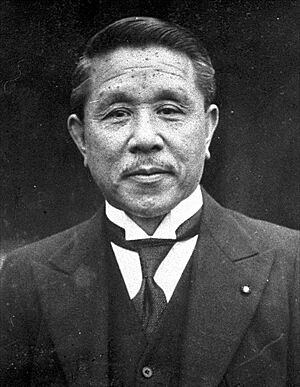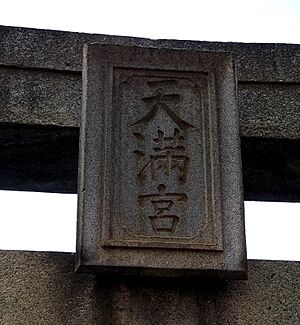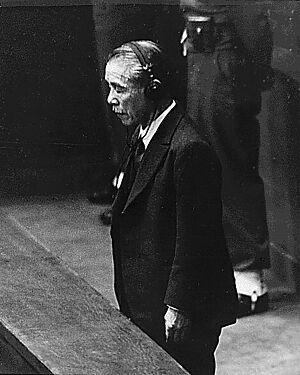Kōki Hirota facts for kids
Quick facts for kids
Kōki Hirota
|
|
|---|---|
| 廣田 弘毅 | |

Hirota, during or before 1946
|
|
| Prime Minister of Japan | |
| In office 9 March 1936 – 2 February 1937 |
|
| Monarch | Hirohito |
| Preceded by | Keisuke Okada |
| Succeeded by | Senjūrō Hayashi |
| Personal details | |
| Born | 14 February 1878 Chūō-ku, Fukuoka, Empire of Japan |
| Died | 23 December 1948 (aged 70) Sugamo Prison, Tokyo, Occupied Japan |
| Cause of death | Execution by hanging |
| Political party | Independent |
| Spouse | Shizuko Hirota |
| Alma mater | Tokyo Imperial University |
| Signature |  |
| Criminal conviction | |
| Criminal status | Executed |
| Conviction(s) | Crimes against peace War crimes |
| Trial | International Military Tribunal for the Far East |
| Criminal penalty | Death |
Kōki Hirota (廣田 弘毅, Hirota Kōki, 14 February 1878 – 23 December 1948) was an important Japanese diplomat and politician. He served as the Prime Minister of Japan from 1936 to 1937. His original name was Jōtarō (丈太郎). After World War II, he was held responsible for actions during the Second Sino-Japanese War. He was sentenced to death at the Tokyo Trials.
Early Life and Education
Kōki Hirota was born on February 14, 1878. His birthplace was in what is now Chūō-ku, Fukuoka, Fukuoka Prefecture, Japan. His father, Hirota Tokubei, was a stonemason.
Hirota's writing skills were noticed from a young age. When he was just 11, he wrote the name plate for the torii gate of Suikyo Shrine. After finishing high school at Shuyukan, he went on to study at Tokyo Imperial University. He earned a law degree from the university. One of his classmates there was Shigeru Yoshida, who later became a Prime Minister after the war.
Starting a Diplomatic Career
After graduating from university, Hirota joined the Ministry of Foreign Affairs. He wanted to become a career diplomat. He worked in many different countries. In 1923, he became the director of the Europe and America Department within the Foreign Ministry.
Later, he served as a minister to the Netherlands. From 1928 to 1932, he was the ambassador to the Soviet Union.
Becoming Foreign Minister
In 1933, Hirota was chosen to be the Foreign Minister. This happened in the government of Prime Minister Saitō Makoto. Japan had just left the League of Nations around this time. Hirota kept his role as Foreign Minister in the next government, led by Admiral Keisuke Okada.
As Foreign Minister, Hirota worked on important deals. He helped Japan buy the Chinese Eastern Railway in Manchuria from the Soviet Union. He also introduced his "Three Principles" on October 28, 1935. These principles explained Japan's goals for its relationship with China.
The three principles were:
- Creating a strong partnership between Japan, China, and Manchukuo.
- Working together to stop the spread of communism in China.
- Stopping any activities within China that were against Japan.
Hirota believed that problems in China, like warlords and communism, were a threat to all Asian countries. He saw military actions in China as necessary "surgery" to fix these issues.
Serving as Prime Minister
In 1936, after a military uprising known as the February 26 incident, Hirota was chosen to become the Prime Minister of Japan. He took over from Prime Minister Okada. To keep the military happy, Hirota brought back a rule. This rule meant that only active-duty officers from the Army or Navy could serve as War Minister or Navy Minister in the government. This system had been used before by the military to influence civilian governments.
During his time as Prime Minister, Japan signed the Anti-Comintern Pact. This agreement was made with Nazi Germany and Fascist Italy. This pact was an early version of the Tripartite Pact that would be signed in 1940.
Hirota was Prime Minister for less than a year. He resigned after a disagreement with his War Minister, Hisaichi Terauchi. This disagreement was about a speech given by a politician named Kunimatsu Hamada. The speech criticized the military's involvement in politics. After Hirota resigned, Senjūrō Hayashi became the new Prime Minister in February 1937.
Later Diplomatic Roles
Hirota soon returned to government work. He became Foreign Minister again under the next Prime Minister, Prince Konoe Fumimaro. During this second term, Hirota did not agree with the military's aggressive actions against China. He felt these actions hurt his efforts to create a strong alliance between Japan, China, and Manchukuo against the Soviet Union.
He often spoke out against the growing Second Sino-Japanese War. The military eventually grew tired of his criticisms. They forced him to retire in 1938.
In 1945, Hirota returned to government service one last time. He was asked to lead Japan's peace talks with the Soviet Union. At this time, Japan and the Soviet Union still had a non-aggression agreement. Hirota tried to convince Joseph Stalin's government to stay out of the war. However, the Soviet Union eventually declared war on Japan. This happened between the atomic bombings of Hiroshima and Nagasaki.
After World War II
After Japan surrendered at the end of World War II, Hirota was arrested. He was accused of being a major war criminal. He was brought before the International Military Tribunal for the Far East (IMTFE) in Tokyo. He did not try to defend himself against the charges.
He was found responsible for several charges, including:
- Waging wars of aggression and violating international law.
- Starting an unprovoked war against the Republic of China.
- Not doing enough to stop violations of war laws.
He was sentenced to death and was executed at Sugamo Prison. His sentence was controversial because he was the only civilian to be executed as a result of these trials.
As Foreign Minister, Hirota received reports about military actions, like the Nanjing Massacre. However, he did not have direct control over the military units involved. Still, the court found him responsible for not pushing the Japanese government to stop these actions.




